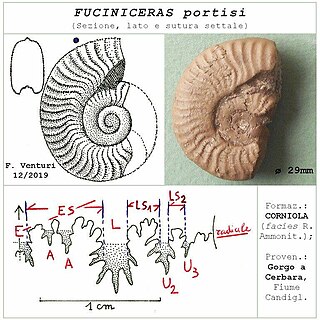Alocolytoceras is a lytoceratid ammonite with whorls that pass during growth from round to oval, rounded-quadrate, or compressed; with about 19 deep constrictions per whorl, with as many as 21 sharp ribs in between. The shell is evolute. All whorls are visible from either side.

Amaltheus is an oxyconic ammonite with a fairly open umbilicus, serrated keel, and slightly sigmoidal ribs from the Lower Jurassic, many of which are strigate. Amaltheus, named by de Montfort, 1808, is indicative of the upper Pliensbachian stage in Europe, north Africa, Caucasus, Siberia, N. Alaska, Canada, Oregon, and possibly Honduras; and is the type for the Amaltheidae and a member of the Eoderoceratoidea.
Asthenoceras is a genus of ammonoid from the Middle Jurassic with dwarfish, evolute, smooth, compressed, discoidal, strongly keeled shell. Asthenoceras belongs to the Sonniniidae and may be a subgenus of the Lower Jurassic Grammoceras.

Arnioceras is an extinct genus of large, evolute, discoidal ammonite from the Lower Jurassic. The shell is normally coiled so that all whorls are exposed. Sides bear strong sharp ribs that are straight until reaching the ventrolateral edge where they swing forward and fade. The rim (venter) is keeled and free of grooves.

Fuciniceras is an extinct cephalopod genus included in the ammonoid family Hildoceratidae,, that lived during the Pliensbachian stage of the Early Jurassic. The shell of Fuciniceras is generally small, evlute, and strongly ribbed.
Glochiceras is a haploceratid ammonite characterized by a small, smooth, compressed, evolute shells with large lappets and a median lateral groove. Its geographic distribution is fairly cosmopolitan, but it is limited stratigraphically to the Oxfordian and Kimmeridgian stages in the Upper Jurassic.
Bifericeras is a Lower Jurassic ammonite belonging to the family Eoderoceratidae, and sometimes placed in the subfamily Xipherceratinae. Whorls are strongly depressed, but still evolute in coiling. The early growth state is prolonged, and smooth, followed by a late growth stage with rounded, straight, bituberculate ribs.
Newmarracarroceras is an ammonite from the early middle Jurassic with a ribbed subinvolute shell with a keel running along the venter, or outer rim. The umbilicus is moderately wide, exposing the inner whorls exposed in part.
Metrolytoceras is an extinct cephalopod genus that lived during the Middle Jurassic, characterized by a planispiral evolute shell with smooth middle and outer whorls, flat sides and simplified sutures.
Lissoceras is an involute, smooth or finely vetrolaterally ribbed, ammonite with a blunt, un-keeled venter, included in the Haploceratidae, that lived from the Lower Bajocian - Middle Oxfordian in what is now Europe, south Asia, and southern Alaska.
Graphoceras is an extinct ammonite genus included in the hildoceratacean family Graphoceratidae that lived during the Aalenian and Bajocian stages, Middle Jurassic in what is now Europe, north Africa, and Iran.

Liparoceras is an extinct fossil ammonite species from the Early Jurassic period of England, and is found in lower Lias deposits. Its name means 'fat head' and this is due to its broad shell. The venter is wide and finely ribbed with no keel and it has two rows of tubercules on each whorl.
Haploceras is a genus of late Upper Jurassic ammonoid cephalopods and the type for the Haploceratidae, similar to Lissoceras but with a broader whorl section and small blunt lappets and a blunt rostrum; some species with feeble ventral folds on body chamber.
Neolissoceras is a genus of haploceratid ammonites with a smooth, compressed, flat-sided shell with a flatly rounded venter and distinct umbilical margin, from the Upper Jurassic (Tithonian) - Lower Cretaceous (Hauterivian) of southern Europe, Madagascar, and India.

Idoceras is a genus of perisphictacean ammonite, belonging to the Perisphinctidae subfamily Idoceratinae. The genus is known from the Upper Jurassic, with a widespread distribution. Shells of Idoceras are evolute, with a wide umbilicus; ribbing strong, bifurcate high on flanks. Suture simpler than in the similar Ataxioceras.

Kepplerites is a moderately evolute ammonite from the lower Callovian included in the Stephanoceratoidea.
Creniceras is a rather small Upper Jurassic ammonite with a shell in the range of about 1.6 cm in diameter,(about 1/2 in). The shell of Creniceras is eccentrically coiled, compressed, and generally smooth, except for a median row of cockscomb serrations on the body chamber and the possibility of blunt ribbing on the sides.

Lytoceras is an ammonite genus that was extant during most of the Jurassic and Cretaceous periods, and is the type genus for the family Lytoceratidae. These cephalopods were fast-moving nektonic carnivores.

Lobolytoceras is an extinct genus of ammonite in which only the inner whorls have large swollen ribs, later whorls have wrinkled growth lines which coarsen somewhat, near the aperture. The genus is known from the Lower Jurassic Toarcian of Europe. The type species L. siemensi (Denck) came from the Upper Toarcian of Germany.







